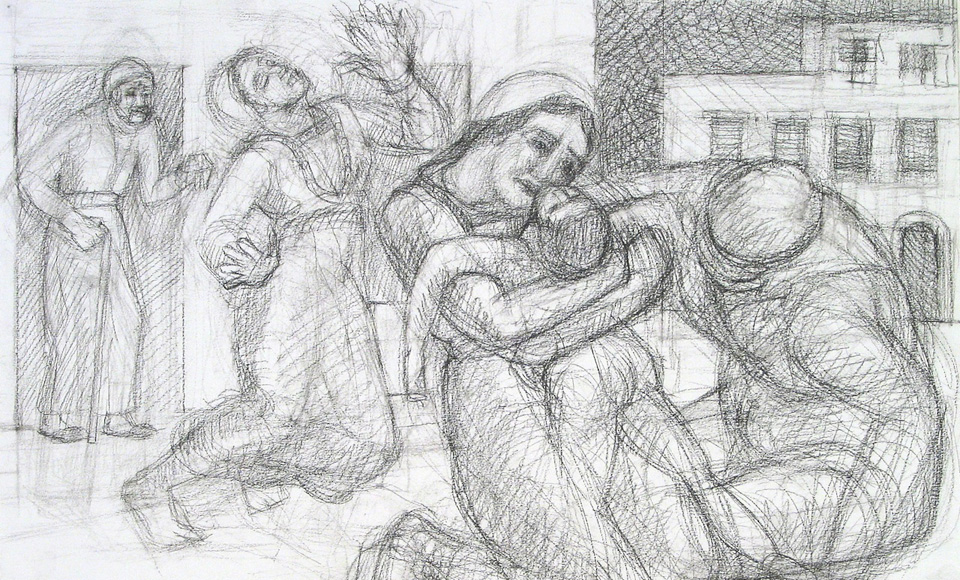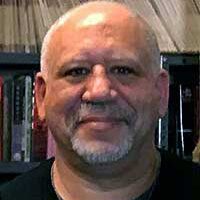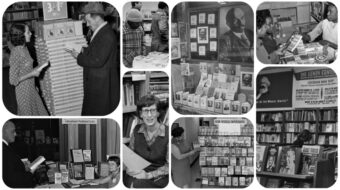
Samia Halaby has created a moving set of images melded with text into a seamless whole, a beautifully designed and produced book, Drawing the Kafr Qasem Massacre. She is a Palestinian contemporary artist and teacher with work in many public and private collections including that of the British Museum, the Guggenheim, Chicago Institute of Art, Detroit Institute of Art, Arab World Institute, Matahf: Arab Museum of Modern Art, and others.
Drawing spans the formats of art book, creative process diary, and documentary. The art is illuminated and contextualized by intimate notes on the process and interpretive thinking underpinning the art’s creation, helping to ensure that the political meaning of the art is not open to reinterpretation or distortion. The actuality of the Kafr Qasem massacre is always kept at the center of the art and of the book as a whole, which includes a substantial sampling of the available documentary history.
In the face of the Trump administration’s effort to divide the global working class by encouraging hate-filled nationalism and isolationism in the U.S., it is important to counterbalance his rhetoric with the reality that is all too familiar to those in countries living under imperialism and the violence and disregard for life which goes with it. Drawing captures this reality in multiple dimensions, including historical context, the voices of the survivors in documentary form, and the beautiful pictures which Samia Halaby has created.
About 25 minutes before 5 p.m. on Oct. 29, 1956 the Israeli “Border Patrol” announced a 5 p.m. curfew in the village of Kafr Qasem, which is inside the Israeli borders. The announcement came at a time when many workers were not in the village and had no communication with people there. Then, before 5 p.m. the “Border Patrol” started killing. “In less than three hours… Israeli soldiers killed 49 people in… Kafr Qasem. They were mostly workers and children returning home in the evening,” Samia Halaby writes.
Eleven discrete actions occurred, nine “waves” at the western and sole entrance to the village, one in the village itself, and one in the nearby fields. Unarmed Palestinians were slaughtered in cold blood as they rode or walked along the road, came out of their homes to see about loved ones, or walked in the fields. Samia Halaby cites the remarks of one of the Israeli soldiers: “We were like Germans. They stopped trucks, took the Jews out and shot them. Same with us.” Forty-nine Palestinians were killed, others were left to bleed among the dead all night, then thrown roughly on the back of trucks and taken to the hospital.
Salman Abu Sitta’s article “Massacre as a Tool of Ethnic Cleansing” is included in Drawing. As Sitta notes, after “November 1947, just after the United Nations recommended a Partition Plan, and throughout 1948 and 1949, the people of over 600 towns, villages, and hamlets were uprooted from their homes by force of arms and threat of imminent slaughter. … This uprooting of Palestinians from their homes and communities was conducted by a foreign superior military force organized, planned, and financed and supported by colonial powers outside Palestine and motivated by an ideology built on the myth that ‘Palestine is a land without people’ and ‘Palestinians do not exist.’ Its objective was to make Palestine a land without people and eliminate Palestinians by massacre and expulsion so that they no longer existed in Palestine.” Over 700,000 Palestinian people were thus driven from their homes during the Nakba, the catastrophe.
Sitta quotes Ze’ev Jabotinsky, an early leader of an extremist Zionist faction, who said in 1923: “Their [the Arabs] voluntary agreement is out of the question… Zionist colonization, even the most restricted, must… be carried out in defiance of the will of the native population. This colonization can, therefore, continue and develop only under the protection of a force independent of the local population — an iron wall which the native population cannot break through. This is, in toto, our policy towards the Arabs.”
The history of Israeli state relations with the Palestinian people from 1947 until today implements this Zionist iron wall policy, a policy seeking the ethnic cleansing of Palestinian people from their homes and the region of their birth, a policy successive United States administrations have supported steadfastly by pouring billions of dollars annually into Israel’s military budget as well as by other forms of aid.
While the broad history of the Palestinian struggle for recognition of their human dignity, an end to ethnic cleansing, and power to develop as a people is fraught with tragedy, the Palestinians are also resilient and have done more than just survive. In one touching moment in the book, Samia Halaby describes one of the women from Kafr Qasem, Aishy Amer, key to helping the artist pursue the project of her artistic rendering of the massacre. Samia Halaby writes: “At that time she [Aishy Amer] lived in Germany and we planned to meet. Eventually she came to visit me in New York. The beautiful scent of revolution and national resistance was all over her in each word and gesture.” Just wonderful!
In another light moment, though referring to the slaughter of women captured in the picture “Embrace in Death,” Samia Halaby mentions: “The women looked stiff and lacked the body language that I came to know as that of Kafr Qasem women who possess a certain pride of posture and feminine coquettishness that is charmingly self-aware.”
Throughout the book the dignity of the children, women and men of Kafr Qasem in the face of the most extreme Israeli state violence and terroristic behavior is pronounced. That Drawing captures this dignity and humanity so deeply and so clearly is at the heart of its beauty.
In Drawing, the images are stunningly beautiful, as is the book design and production. Samia Halaby describes the book as “…a combination of drawings and words… it became two books in one, one based on drawing and another based on documentation.”
This reviewer read the book in one sitting. Such was, for me, the power of the images and in the documented voices of the survivors.
The images are placed in a rich context by interviews and reports from first-hand witnesses and survivors, an article by an Arab Jewish journalist from Iraq newly immigrated to Israel who defied Israeli edicts and military cordons to visit Kafr Qasem soon after the events occurred, and the report by a Palestinian Arab Communist representative to the Knesset bringing the tragedy to world attention.
Much of the art is conté crayon or pencil on paper, lending a vibrant immediacy and intimate truth to the images that is compelling. Emotional and factual authenticity combine to engage the viewer with the Palestinian people being depicted, the oppressed, even in the process of the unfolding massacre.
The authenticity arises not only from the artist’s commitment to creating images consistent with survivor oral accounts and documentation, but also from the artist’s personal experience. As Samia Halaby observes, “Even while examining my failures and considering my doubt, a fact remains that empowers the drawings. I am the one who makes the drawings, a Palestinian woman who experienced the Nakba and lives the history of Palestine.”
This reviewer’s sense of participating in a living process was pronounced. This process was an intersection of the artist’s creative journey as captured in notes and images, unfolding events of the massacre captured in documentation from multiple viewpoints, survivors’ attempts to deal with the experience, and the reader attempting to grapple with a growing understanding of the inhumanity of the massacre and the impact it had on survivors whose grief was magnified by their callous treatment by the Israeli state.
This reader was unwilling to break away, to skip one word, to avoid allowing any detail of the images from resonating in my heart. As Samia Halaby noted, “I wanted the victims to be known, named, and looking out at the viewer at the moments prior to death. In this way the viewer could meet them as they gazed back from the drawing….” Meet them I did.
Drawing is powerful, intelligent, compassionate, challenging, and enlightening, well worth the time to engage with the people of Kafr Qasem, those who were victims and those who survived the massacre, and with the amazing Palestinian woman artist, Samia Halaby, who offers such heartfelt exploration into her creative process while illustrating and documenting the relatively unknown but very important, tragic event, the massacre of 49 Palestinians on Oct. 29,1956.
Halaby, Samia.
Drawing the Kafr Qasem Massacre.
Amsterdam: Schilt Publishing, 2016










